Flowers are returning to the Priory … after selfishly leaving me all alone for long dank months. Still, no hard feelings.
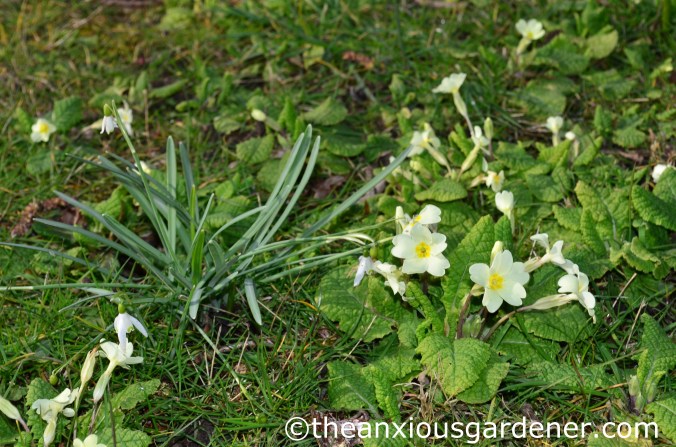
There are cautious whispers and murmurings as my fair-weather friends slowly heave themselves out of bed.
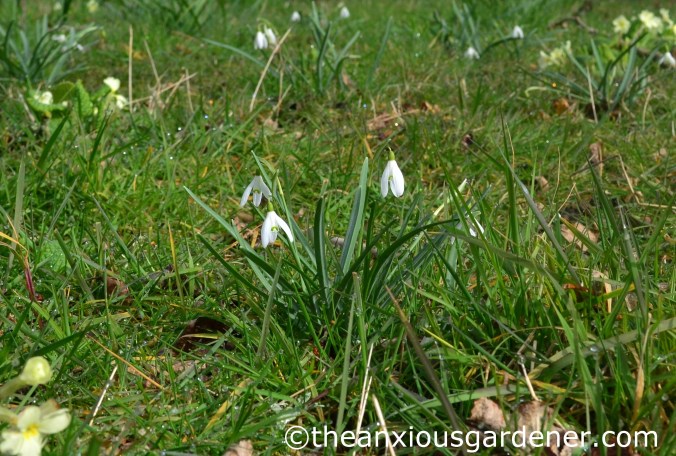
Beneath large oak and ash on the meadow, small pockets of snowdrops have returned. I did wonder whether they’d bother; having been so rudely spiralled out of their original homes with a bulb planter. Whilst the results won’t tickle you giddy, I hope that these few flowers are the outriders for a dense carpet. One day.

On the bank below the greenhouses transplanted groups have re-appeared too.

They kept me waiting on this north facing slope and I was beginning to worry that something (voles?) had nibbled the bulbs. But no, here they are.

There’s not a lot of crazy flower action in the Rock Border: snowdrops again, a keeled over Helleborus foetidus (need I really stake them? Surely no-one stakes stinking hellebore, do they?)

and, just past their prime, a few non-stinking hellebores. I remember initially not liking these and thinking them funereal. I was wrong.

Pulmonaria, which I also have in the Rock Border, is new to me. A couple of years ago, I was given a few dug-ups by my mum-in-law, the font of my gardening knowledge. I’d seen them on the telly and in books but I didn’t think they seemed particularly lovely and wondered what all the fuss was about. But heck, if I can be wrong about hellebores, what do I know? Having now grown them for a while, I’m sorry to say – I still don’t know what all the fuss is about. Is that heretical? I should think so.

I’m not particularly taken by their wishy-washy flowers (burn him! Burn him!) and mottled leaves. I shan’t pull them up and stomp them with big boots; it’s not like I hate pulmonaria.

I’m just disappointed that after all the hoo-hah, their beauty doesn’t lift me.
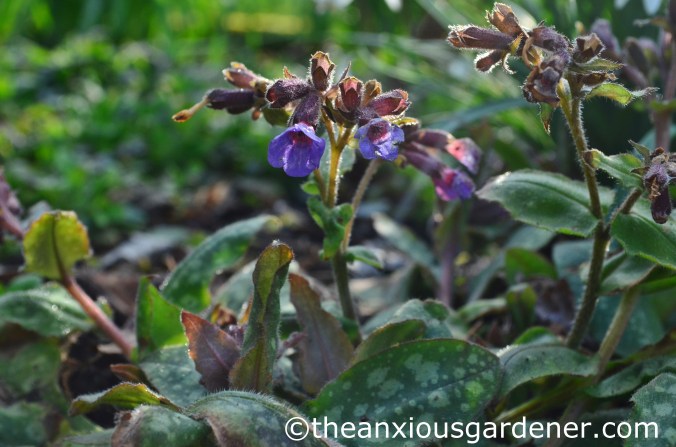
Pulmonaria? OK, I suppose, but honestly? Meh. (Burn him! Burn him!)

Give me a bright sunny daff any day of the week. A short-lived pleasure maybe but one whose foliage isn’t in need of ointment.

On a less grumpy note: in the wild, north-eastern corner of the garden sits an old willow stump. Five years ago, I removed a forest of regrowth but left half a dozen shoots to form a (insert noun here. A goblet? Vase? Cage? Nonsense?).

March 2011
This is what it looked like before I set to.
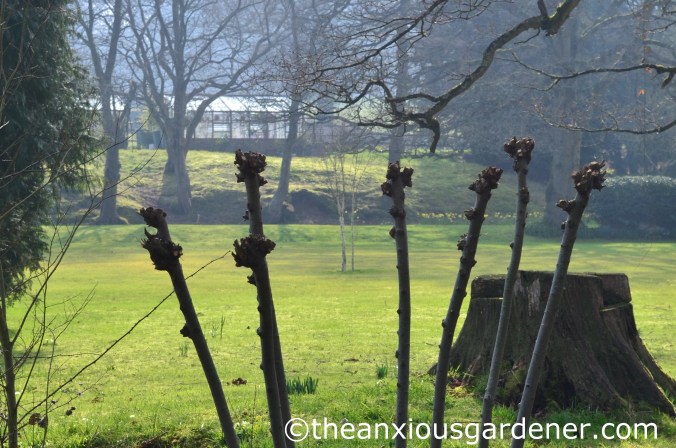
I pollard the trunks each spring and slowly they thicken and the ends swell. You might remember that I mentioned it in a very early post – Suckerin’ Succotash. Personally, I like the effect – though you may not agree. But there is something about brutal, clenched willow fists, isn’t there? No? Ah, just me then.
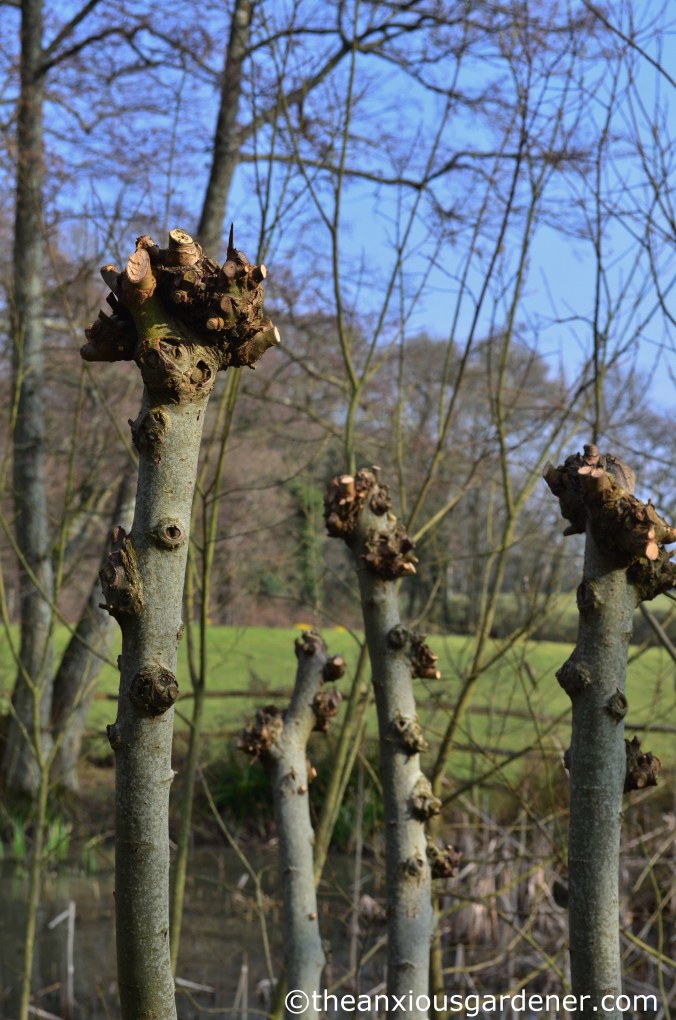
They look like something Bill Sykes might grab for a Saturday night out . But actually they’ll soon be smothered and softened by pale green shoots and frail leaves.
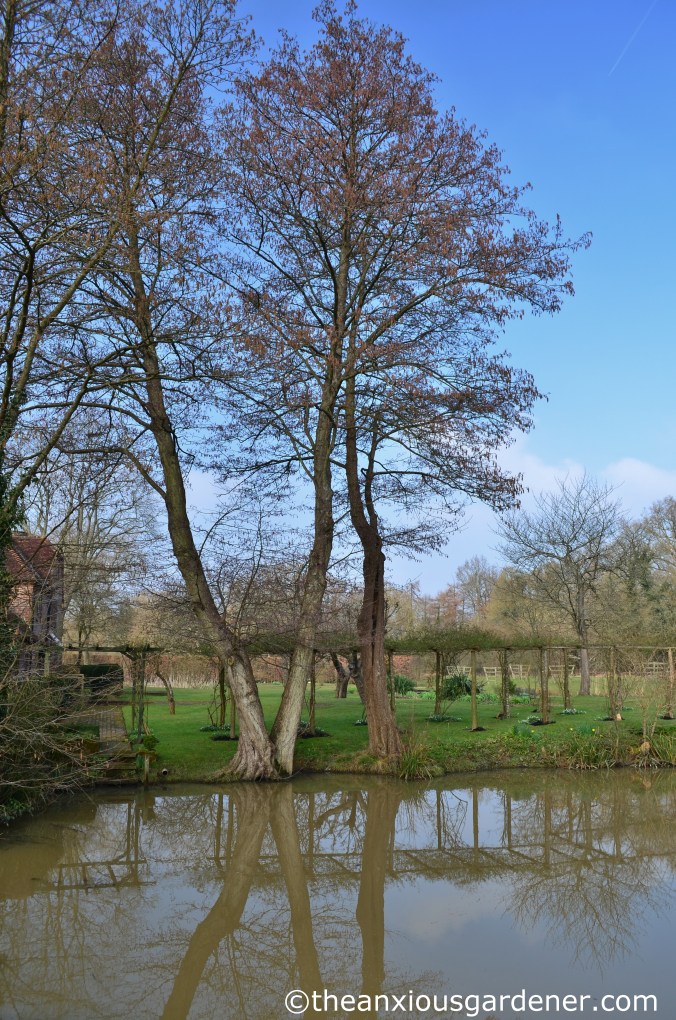
The alder on the right has a split trunk, declared unsafe by the tree surgeon it is ear-marked for felling
I’m rather taken by alder. This wasn’t a tree I knew very well (prior to Priory) – other than as a water-loving, weed-tree. I also thought of them as small, like birch, but some of ‘mine’ are nothing of the sort.
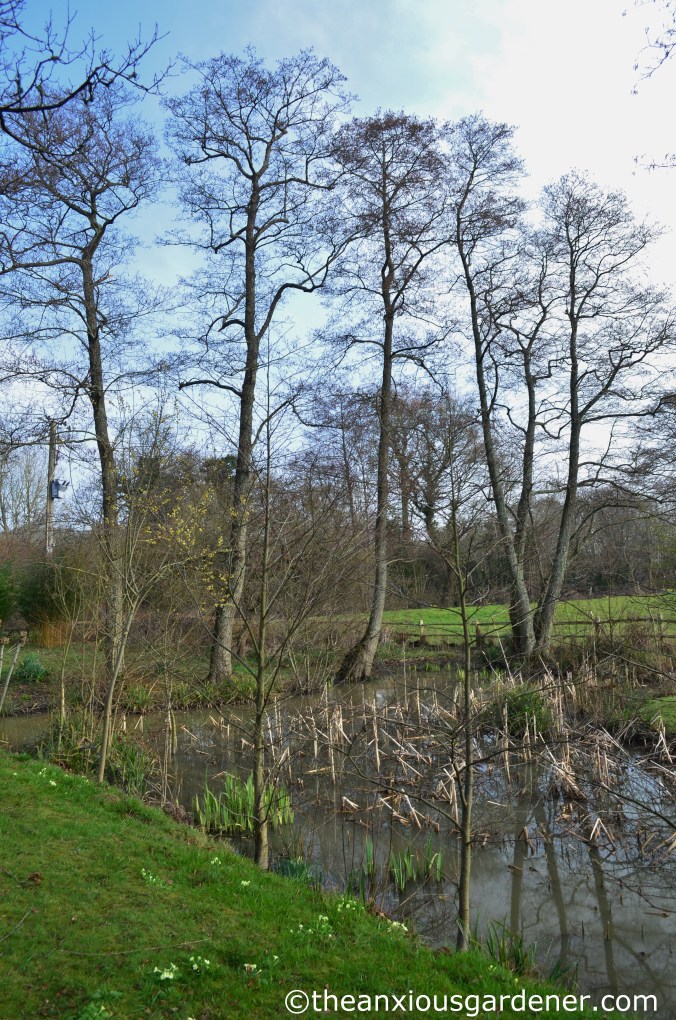
They do have the irritating habit of suckering dementedly and removing these takes an age. But hey, we all have our quirks and foibles.
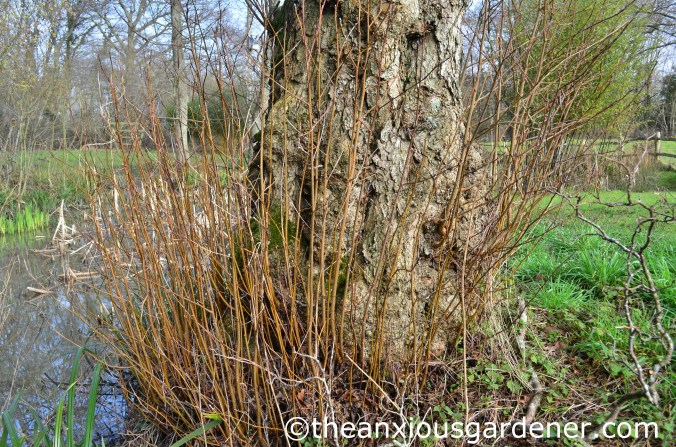
Alder tree suckers
Cutting off the suckers however is a quietly satisfying and absorbing job (whilst listening to Dad’s Army or Round the Horne on Radio 4 Extra) but I take care to avoid an unseemly splash into the pond, as funny as that might be. I’ve almost come a cropper once or twice.
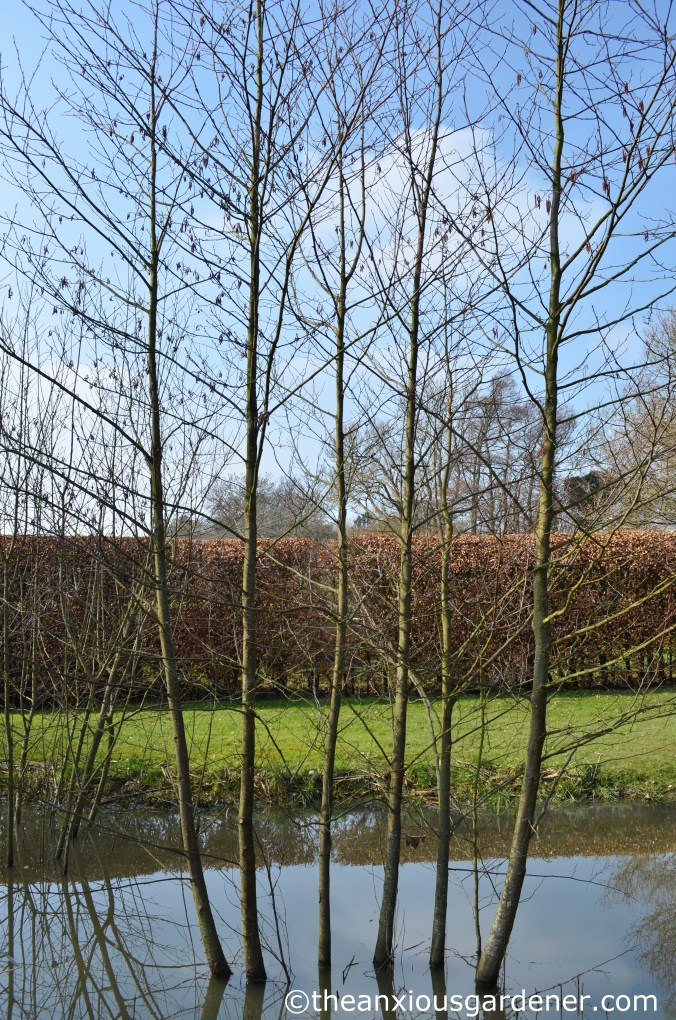
Alder is a rampant suckerer (?) and a rampant self-seeder too. I’m forever removing wayward (and unloved) offspring but I’ve left a handful be: like this grouping near the west pond, thinned out into a line of six.

There’s also a line of adolescents loitering in the ditch, which I’m mulling over. I haven’t decided yet whether to pollard these, give them free rein or take them out completely. I need to press my finger hard against my chin and think.
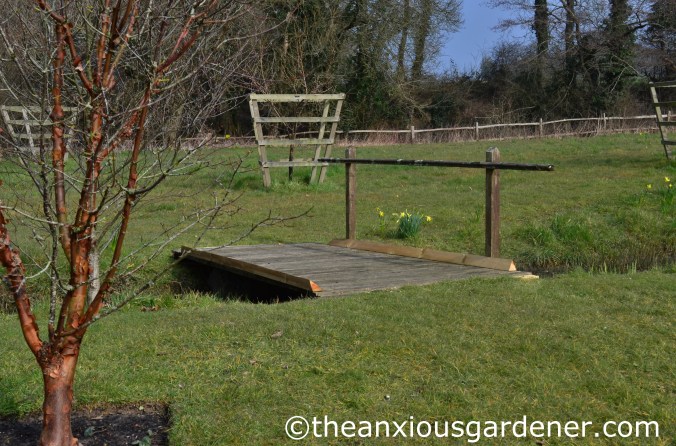
I like his unasked for rails which help prevent trailer wheels slipping off the edge
Thanks to Jim, the bridge over to the meadow is reborn. (I carelessly lost the old one during a recent flood). We salvaged most of the timber from the original, triumphantly found a couple of steel girders in an outbuilding and Jim bedded them in concrete. A biblical flood might shift the thing but if we suffer one of those, the loss of a garden bridge is of small concern.
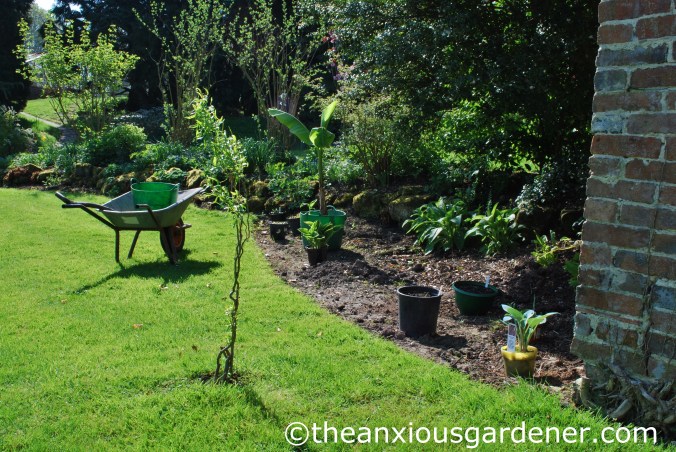
Anyway, let’s return to where your heart is – pollarding. I’m planning on doing just that to one of my twisted willows. Wasn’t it a sweet, little sapling in 2011?

Now look at it. The beast. Its grown so quickly – like Jack’s beanstalk. I’ll defer pollarding for another year as I’d like to see how big it’ll reach during another season. If you want a really, really fast growing tree for a damp area, Salix tortuosa is your boy. And he grows big – over 12 metres – hence my intention to start pollarding.

Very old, very beautiful pollarded ash tree. Langstrath, Cumbria
(Eggs, grandmother time. Pollarding is the ancient practice of lopping a tree’s upper branches or trunk at head height. The tree – usually hazel, ash or beech – responds with a frantic, panicked surge of regrowth which is harvested for fodder or, if left for several years, cut as poles for whatever you might need a pole for: fences, hurdles, fighting Robin Hood on a bridge, that sort of thing. Because the pollarded tree doesn’t reach maturity they can live far longer than their uncut brethren. Coppicing is similar but the tree is cut down to ground level; pollarding puts the new shoots out of the reach of cattle and naughty deer. It is still widely used but usually to limit tree size, as I do, rather than to produce a tasty snack for your cow. Grandma, egg, sucking time over).
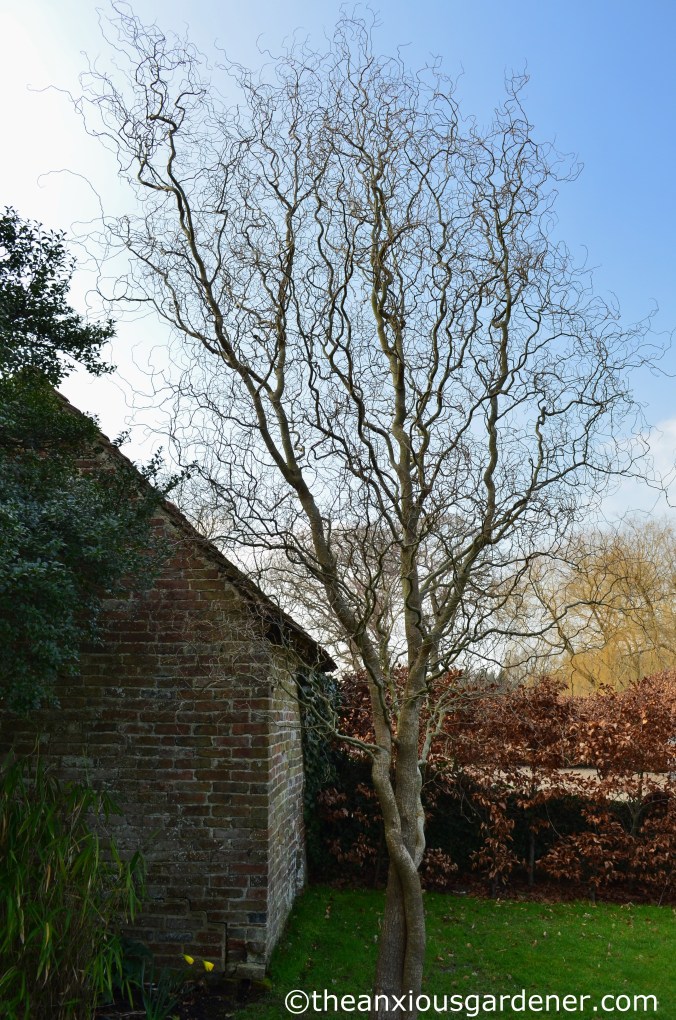
The twisted willow started life as a handful of twigs cut from a neighbour’s tree (I asked first). Isn’t that an amazing zest for life? From a twig to this in about six years? I think so. I wound the twigs into a spiral but it didn’t really work. Fun to experiment but I’d suggest a single twig will produce a more elegant form.
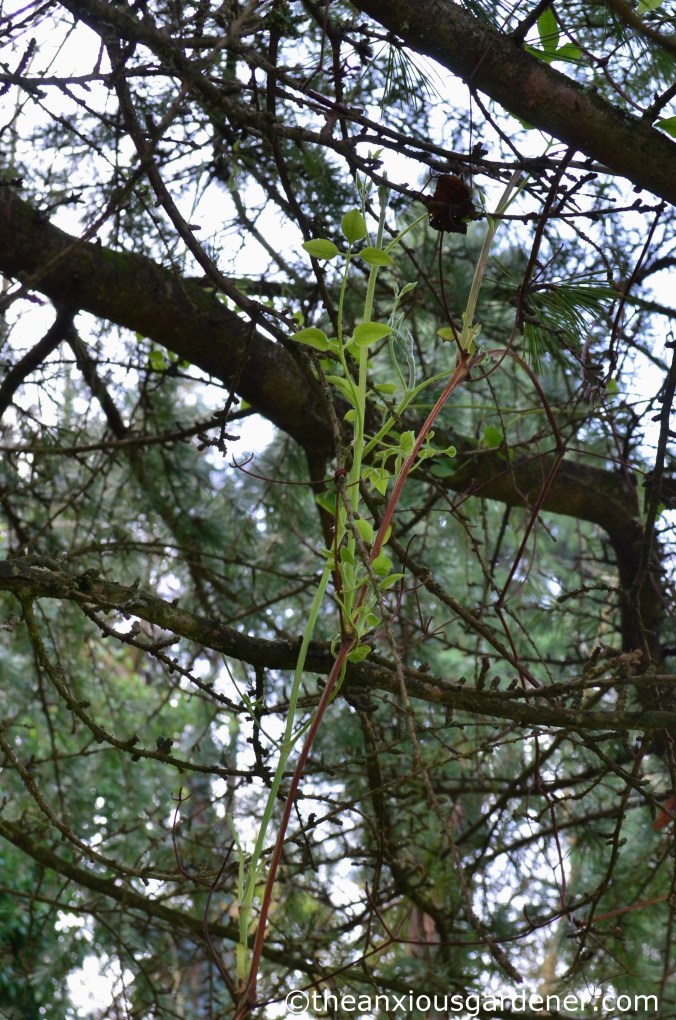
Last month, I mulched and fed my twenty-odd clematis. I wouldn’t normally do so in February but with the very mild winter they’ve been terribly confused, poor dears, and have barely stopped growing. I thought they could benefit with an early feed. This C. ‘Huldine’ is relatively sheltered growing up through a cedar and is miraculously untouched by frost
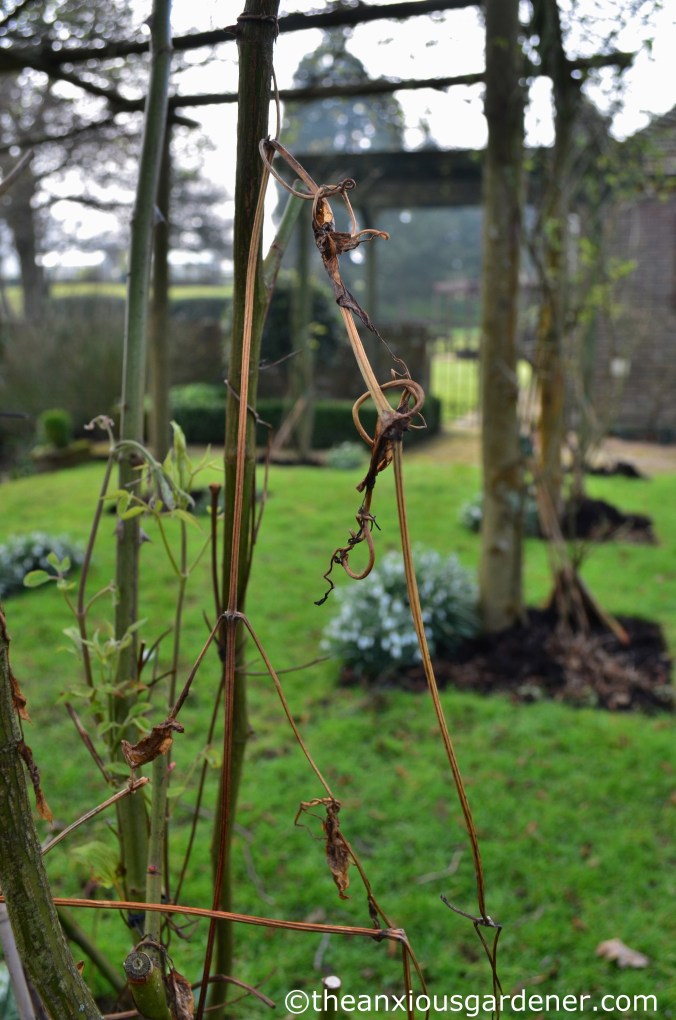
but others have been shrivelled. Silly clematis. They carry on shooting prematurely and repeatedly like it’s April.
That zest for life is a wonderful, powerful urge.
oooOOOooo

Crocus ‘Ard Schenk’
Those of you who are far too busy (and sensible) to engage with social media, possibly missed a Sunday Telegraph article – The Gardening Bloggers You Should Be Following. It listed sterling blogs and The Anxious Gardener got a nod too. I hesitate to mention it as I’m still uncomfortable with self-publicising. But, I have learnt and certainly been told, that if you don’t tootle your own bugle no-one will tootle it for you. (Er, possibly for payment they would). It’s been a curious few days with my normally mundane viewing figures rocketing. Very odd. I haven’t featured in a national newspaper before and, as I probably won’t again, I thought I should tootle.
Toot toot.
Yours, a sensitive soul. Apparently.
WAHHH – what’s happened to your wonderful photos – I used to be able to see them full size & save them to a desktop slideshow – do you not want to let peopke do that perhaps? There’s no right click capacity on them 😦 I’ve not visited since late last year so apologies if you’ve perhaps dealt with the topic before now.
I want so many – esp many from this post so it would take me ours to advise you of which ones given I’ve yet to work through more older posts to see how many others I might want. 🙂
Thanks
Romayne
LikeLike
Hi Romayne, yes I’m sorry about that. It isn’t intentional – I must have inadvertently changed the post settings. I realised as I was writing Margaret’s Farm and changed each photo individually so that they open on clicking but realise that isn’t possible on some photos in older posts. I’ll have a root about in WordPress settings right now to see whether I can change the default back to click-able photos. Dave
LikeLiked by 1 person
If it helps, and if you self-host like me, I noticed a few weeks ago that the image gallery (the “media library” for the technically minded) had somehow changed its defaults and clicking on images produced an unexpected result! The gallery saves the last used settings as default so to “correct” just go into the post editor for any old post. Click “add media”. In gallery window select any image. Now look at the “Attachment display settings” bit on the right. Click on the “link to” box and select “media file” from the drop down menu. Click the “insert into post” button. Back in the post editor, delete the image you’ve just added.
To check it’s worked, click the “add media” button again. in the gallery editor, single click on any image and look at the “attachment….” bit on the right again. It should now show “Media file” in the link to box and the box below that should show the url of the image.
Cancel back out. Voila. For future images all should be well. Tho you will need to go back and edit each of the previous piccies if you’re so inclined.
LikeLike
That’s very helpful. Thanks John. I had a quick look this morning before coming to work but couldn’t find a straightforward, obvious solution. I’m not self-hosted but I’ll try your solution later and hopefully it’ll work on wp.com. Dave
LikeLike
Another good reason for pollarding over here is that it costs a fortune to get tall trees lopped over here so it is better to keep them at a manageable height. However, we find it very difficult to cut when it looks so ugly in the beginning. You really need a good bit of imagination. Amelia
LikeLike
I planted a eucalyptus in a previous house and told the new owner that I removed all the branches every year or else it would grow enormous. She said she would do the same but didn’t and it must be 60ft tall now. As you say, it’ll cost a pretty penny for it’s removal or pollarding. Dave
LikeLike
Love reading your gardening thoughts. I agree re. pulmonaria, They look like they are diseased. A bit like Elephants Ears, I keep looking at them, and keep thinking, “nope”. My blog is brand new, I hope maybe one day, I could emulate some of your success.
LikeLike
I’ve just been removing all the leaves on my EE’s. They quickly grow new, bright ones without the horrible blotches. I used to dislike them too but I’ve come round a little. They do serve a purpose in a dry, shaded area. Good luck with your blog. Be warned, it will eat up all your spare time like a demented Pacman! D
LikeLike
Reblogged this on Schattengarten Blog and commented:
Ein wunderbarer Frühlingsbericht meines Lieblingsgartenbloggers aus UK, David Marsden
LikeLike
Vielen Dank für das. Dave
LikeLiked by 1 person
Gern geschehen. Ich wartete schon auf Deinen nächsten Post. I’m still waiting for your next blogpost.
LikeLike
Probably tomorrow!
LikeLike
I love to see coppiced dogwoods and pollard willows in the winter. Have you seen Salix alba ‘britzensis’, the winter colour of the new growth following pollarding is brilliant.
LikeLike
There are some beautiful, pollarded willows in Sussex and they always catch my eye. I have seen that salix before but just reminded myself with a look on Google. Astonishing colour – they’d look great about the ponds. D
LikeLike
OK, I am writing as if I am your friend that will tell you when your breath smells, when you need to clip your nose or ear hair or when you should never wear that shirt again. Your Best Friend, right? So all this anthropomorphising plants is just cringe making. They are not your friends. They don’t do friends. They behave just as the seasons and weather dictate and this has nothing to do with you. You are not writing for 5 year olds.
I like the pollarding stuff. At least you didn’t suggest that the trees would be grateful for your cutting. Don’t quote Blake, worms and ploughs back at me. He was talking bollocks, too.
I think it would be fun to leave the trees in the ditch if they can cope with that. But don’t expect them to thank you for it.
LikeLike
I do wish, Charles, you wouldn’t pussy-foot about when leaving comments. For goodness sake, just say what you mean. Sorry you didn’t like the post but I’m grateful for any feedback or criticism, even if I don’t agree. I can only write using my own judgement, style and taste, rather than yours or anyone else’s. That’s the nature of amateur blogs isn’t it and what keeps the whole blogging community so very diverse? Like it or not. Dave
LikeLiked by 1 person
I gave my pulmonaria away as I was so under-whelmed. But it has slyly self-seeded (quite how as I never saw flowers on the original) and now has flowers. And it has grown on me….. Congratulations on being listed in The Telegraph article 🙂
LikeLike
Well Helen, I’ve lost count of the number of plants I disliked on first introduction only to be seduced later. Don’t be too surprised if, in a year or two, I write a post waxing lyrical about the subtle charms of pulmonaria. D
LikeLike
😀
LikeLike
I’m ambivalent about pulmonaria; no strong feelings there. (But early insects love them…) Pollarding, on the other hand, is among my absolute favourite garden tasks. Anything that involves a pair of loppers, secateurs or a hacksaw and I’m there. We used to have a beautiful Catalpa bignonioides purpurea in our previous garden and pollarded it so it grew fabulous, handkerchief-sized leaves each year. Congrats on being featured in the national press (exciting).
LikeLike
Hi Sam, an evangelical pollarder, eh? Good for you. To be honest, I’d have pollarded the twisted willow already but I thought I’d better check with the owner first. He isn’t quite as evangelical as I. D
LikeLike
Congrats on the article…You weren’t ‘mentioned’, they BEGAN with you…Very well deserved imo : ) Some other great ones also mentioned, that I shall definitely check into. Really love Non Morris’ blog. Love your twisted Willow…a contorted Salix with pollarding potential, or the alt band you wish you began as an angry twenty-something??? Incredible to be able to grow a new tree from a stick…Did that with our Ribes sanguinarea, and also very ordinary but much-loved lilac. Enjoyed your post immensely, as usual…Also learned something…Had somehow confused pollarding with coppicing and had been using the former term, when actually meaning the latter. Do you grow any of the shrubby dogwoods? There are some really lovely ones, esp. ‘Midwinter Fire’ which respond very well, as I’m sure you know, to coppicing. Jealous of your clematis collection. Huldine is a nice one..Good to see the return of spring blooms and also favourite bloggers : )
LikeLike
Contorted Salix? Great band, very ahead of their time and underrated, imho. Yes to the dogwoods but not Midwinter Fire – though my mum-in-law grows it. I wasn’t sure about it at first – until that is the sun came out. She has hers high on a bank and it is indeed fiery. I’ve been cutting back my green and red cornus recently – and again earlier than usual – as they were coming into bud. The Huldine went in last year. I bought it as I wanted a really BIG show-off. It didn’t flower but is already about 8ft tall. I’m hoping for a BIG show this summer. Fingers crossed. D
LikeLiked by 1 person
Good luck with C. Huldine..you’ve probably heard the saying, regarding Clematis, ‘First year sleeps, second year creeps and third year leaps.’ Sounds like it’s growing like mad. I’ve started usingTomato food on flowering vines, and it really seems to help for profuse blossoms. Enjoy..Look forward to hearing how the new garden is coming along over the spring : )
LikeLike
Hadn’t heard that saying actually, Jo – so thanks. It seems true enough in my experience too. Not too much happening in the new garden, I’m afraid. I’ve been painting over new plaster with watered down emulsion – which isn’t a joy. D
LikeLiked by 1 person
Reminds me of the mind-numbing process of removing the palimpsest-like layers of wallpaper from the walls of our house. Oh, the joys of the home : )
LikeLike
Done that as well in several houses, Jo. Here, though we are able to simply plaster over the er, interesting wall and ceiling painted-on-textures. Expensive, but satisfying. D
LikeLiked by 1 person
Think that would be the to follow if we were to do it again…In the early days, it was the only option..Good old DIY ; ) I’ll be in touch soon…hoping to ask a bit of advice about walks and contact info for…All best, Jo
LikeLiked by 1 person
Wait until you see a Hairy Footed Flower Bee on your pulmonaria – you might change your mind!
LikeLike
Well, there were bees feeding whist I photographed them, Philip – sadly I couldn’t tell the hirsuteness of their feet. But I was pleased that the pulmonaria fed them. D
LikeLike
In case you need any encouragement: https://philipstrange.wordpress.com/2015/04/10/loitering-by-lungwort-peering-at-pulmonaria/
LikeLike
Thanks Philip – you’ve made me soften my stance on lungwort. A bit. D
LikeLiked by 1 person
Demented suckering is a mild quirk compared to some, I suppose—such as the need to pollard innocent trees. (Tsk.) I can see the usefulness of pollarding and the intrigue, but not yet the beauty. But then, a few years ago I didn’t appreciate hedges as they deserve. (I have a Lady Banks rose with the same zest for life as your twisted willow. It’s beginning to be worrisome, actually. Perhaps I should pollard it.)
When I lived in Vermont pulmonaria was mostly exciting because it wasn’t a snowflake or a mud puddle, and that was mighty exciting indeed.
LikeLike
There you go, Stacy – from distaste of pollarding to acceptance. All within one paragraph. Love the Vermont angle on pulmonria (a State name which still instantly makes me think of pulling back the barn doors to show the snowfall behind the Christmas tree). D
LikeLiked by 1 person
Hoorah… Huzzah… You’re back.
I’ve a newly discovered Pulmonaria lurking in my garden. It’s pink and purple at the same time! Pretty cool I thought!? No? Oh alright then. Off to the stake with you. ; )
LikeLike
Hi Caro, I’m glad you like yours – want any more? I have plenty. (Margaret told me of your meeting. How funny is that? What a tiny little world we inhabit). D
LikeLiked by 1 person
I know! Isn’t it! If you want some adopted then I can offer a good home lol 😊
LikeLiked by 1 person
Pulmonaria is rampant here. It grows everywhere.. from a rock hard in summer south facing slope to the permanent bog garden down by the river. Given its soil covering capacity and apparent resistance to the critters that manage to eat everything else.. it can stay.
LikeLike
Interesting Jessica. Plenty of suggestions here for better varieties than mine – I need to broaden my horizons. Dave
LikeLike
I loathe pollarded fists.
But. Cutting a too vigourous tree to head height … perhaps that would help me live with some of our inherited monsters like fiddlewood.
Congratulations on the well-deserved honourable mention!
LikeLike
Fair enough re the fists, Diana but I’m jealous of anyone who has monsters called fiddlewood. Marvellous name and very Middle Earth. Dave
LikeLike
It is a polite and friendly tree, whose leaves turn orange as summer approaches. Inherited with the garden. Mystery was solved when the leaves turned.
LikeLike
OK, thanks. It sounds lovely – especially polite and friendly. (Unlike blackthorn, for example). D
LikeLike
Show me a garden blogger who doesn’t self-publicise and I’ll show you someone who needs to wake up. Incidentally, check out #gdnbloggers on Twitter, Or join us for a tweetathon on Sunday 20th March at 7pm. I’ll add your blog to our list if you ask nicely. Meanwhile, with all these awards and mentions, you’ll need to widen the doors in your new place (at least the top bits).
I’ve chopped half of my clematis down for February (that’s the half that’s called “clemahtis”) The other half, the Montanas, which I call the “clemaytis” and so get round the “how to pronounce” issue, self-pruned, along with a rather nice pyracantha, in Imogen. I think it was Imogen and not Juno. No floods, just a lot of snapping!
And I’d have expected a little pic of the new garden by now …..
LikeLike
Hi John, thanks for the twitter hashtag – I didn’t know about that. Please do add me to your list (is that nicely enough?) and I’ll try to remember to use it – though my memory is shocking. I pruned most of my clematis in early January as they were already sprouting way above my head. I will do a post about the new garden at some point but really? Don’t get too excited. D
LikeLike
Super post – thank you
Trudy Harpham PhD Emeritus Professor at London South Bank University, UK
LikeLike
Thanks Trudy. Dave
LikeLike
Tootle away – congrats!
You’ve given me courage to go hard on my variegated Japanese willow, which has grown a bit out of hand.
Regarding Pulmonaria, may I suggest ‘Diana Clare?’ I adore mine! It is more about foliage than flowers, which come and go, but the leaves stay strong all season and don’t fade.
LikeLike
You and Janet (below) obviously share the same taste, Eliza – she’s suggested the same variety. Thanks for that. I shall investigate. D
LikeLiked by 1 person
It is a beauty!
LikeLiked by 1 person
Oh, just an amazing blog, as always – photos, descriptions, everything! And shining through, your wonderfully humorous writing. That’s it, I’ve tootled your bugle.
Can’t agree with you more about pulmonaria. I’ve tried to like it, even given it a fighting chance in my own garden but it had the heave-ho in the end. Thank you for explaining about coppicing and pollarding; I’ve never been quite sure what they entailed.
LikeLike
Thanks Alison, glad to be of service and to know I’m not alone regards the pulmonaria. I find it tricky explaining something on the blog, not knowing if I’m stating the bleeding obvious! D
LikeLike
Greetings from the mountains of North Carolina. I signed up to receive your blog after reading the Telegraph article last week. Will look forward to watching your garden grow! My latest posting covers lore and legends (can critters predict the weather?) with a bit about the world’s largest rose. Please stop by if you care to. http://www.thedirtdiaries.com Cheers!
LikeLike
I’ll check it out, Lynn. Thanks for commenting. D
LikeLike
Toot toot away! I’m a big fan of pollarding, and am hoping to persuade the folks in charge of our park to Pollard the willows there. Lovely to see your snowdrops shyly emerging in their new homes, the carpet will come. I’m wondering if I should try reproducing from my own twisted willow, assuming they leaf up, they are looking a tad dead, and normally have buds about to burst open by now. As for pulmonaria, I think you may be growing the wrong one, Diana Clare has gorgeous deep blue flowers and almost totally silver leaves. Just saying’…
LikeLike
You’re not alone in suggesting another p. variety, Janet – thanks for the suggestion. I’ve just come back from London and noticed loads of pollarded trees though not as many as on the continent. I think there is something very statuesque about them but I’m not sure why I find them so pleasing. It’s hardly a natural look. If it’s any reassurance, my two twisted willows don’t show any sign of bud yet though I think I’m normally behind you. Hope yours OK. I find one of the biggest problems is sawfly stripping the leaves. Dave
LikeLike
A really interesting early spring post. I agree that alders are fantastic trees. They form a fantastic purple haze in autumn and winter but are just now beginning to glow copper as the season turns. I love their cones, too.
Regarding pulmonaria, They can be rewarding, not least because they flower so early (in our garden they raced the snowdrops this year) and nectar-feeding insects like them. But I have to agree that the variety you’re growing does look pretty disappointing. Can I recommend something a bit different, such as the true blue ‘Blue Ensign’ or pure white ‘Sissinghurst White’? I’m familiar with these, but I see there’s also a deep ‘crushed raspberry’ red called ‘Leopard’, if that’s the colour which appeals. Pics on the RHS website!
LikeLike
Thanks for that. And you’re right about the insects, as a couple of bumble bees were feeding when I took the above photos. You’re probably right about the pulmonaria varieties too. Perhaps I ought to experiment more and will check out the ones you suggest. Dave
LikeLike
I really hope you find some that you like.
LikeLiked by 1 person
I thought for a moment there, sensitive soul, that you were going to finally convince me of the merits of Pulmonaria. But no, as always, you have perfect taste!
LikeLiked by 1 person
I thought I was going out on a limb with the pulmonaria,Janna but it seems I’m not alone. Though it’s been suggested I’m growing the wrong variety and perhaps I am. D
LikeLike